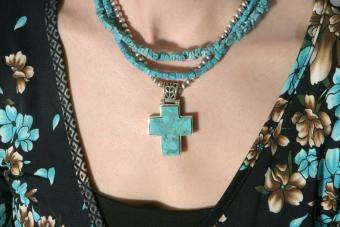
If your sterling or silver-plated jewelry is getting tarnished, you might want to invest in some silver jewelry cleaner to make it look like new again. Cleaning silver jewelry is actually easier than you might imagine, but there are important things to know about the various methods you can use.
What Is Tarnish?
When you first bought or received that silver necklace or bracelet, the piece was probably gleaming. Over time, you may have noticed the metal beginning to darken. This darkening process is called "tarnishing."
Tarnish happens as the silver reacts with the surrounding air. The top layer of silver gradually begins to oxidize and form a black or gray coating on the metal's surface. In many cases, this coating makes the piece seem less lustrous and beautiful than it once did, so you may want to remove it.
Choosing a Silver Jewelry Cleaner
There are actually several ways to clean your silver jewelry pieces. Each method has its advantages and disadvantages, and it's important to understand these before picking one.
Before you choose a cleaning product or method, make sure you know as much as possible about your jewelry. Ask yourself the following questions:
- Is the piece an antique or an heirloom?
- Does this item have a lot of texture or engraving?
- How often do I wear this piece?
- Is this item sterling silver or silver-plated?
- Are there any gemstones in the silver jewelry?
Silver Dips
Silver dips consist of chemicals that quickly remove the tarnish from your silver jewelry. The main advantage of dips is that they are speedy and easy. You can clean several silver pieces in just a few minutes. However, there are some significant disadvantages to this method of cleaning silver jewelry:
- The chemicals in dips can take the coating off any artificial gems in the piece. They may also remove the polished surface from some gemstones, and they can ruin gems like pearl and opals.
- If you do not rinse the dipping chemical from the jewelry, it can continue to corrode the silver, resulting in damage to the piece. Always rinse jewelry thoroughly after dipping it.
- A dip works uniformly on a piece of jewelry. This means that it also removes the patina or aged texture that can show off engraving on the piece. For this reason, never use a dip on antique jewelry.
- Dips can cause etching on the silver.
Silver Polishes and Wipes
Silver polish is the traditional method of cleaning silver jewelry. The idea of polishing your jewelry may call to mind hours spent polishing your grandmother's flatware or silver tea set. However, jewelry pieces are usually fairly small, so the time commitment isn't what you might expect. Many jewelry polishes also come in a convenient wipe style. You can use the jewelry wipe on your piece and then dispose of the mess. Keep the following in mind as you work with a polish.
- Just like silver dips, polish isn't good for some gemstones. Avoid getting the paste or chemical on the stone if you possibly can. If you do expose a stone to the polish, rinse it off immediately.
- Polish may not be best for items with a great deal of detail work. If you aren't concerned with preserving the patina of the piece, you might consider using a dip.
- Disposable polishing cloths or wipes are a great way to keep your silver jewelry in good shape when you're traveling.

Ultrasonic Cleaners
Ultrasonic jewelry cleaners use sound waves to agitate the water and remove dirt from jewelry. These cleaners, which range in price from around $50 to over $200, are sometimes effective in cleaning silver jewelry. However, as with the other jewelry cleaning methods, they aren't appropriate for all pieces. Keep these considerations in mind when using ultrasonic cleaners.
- Do not use an ultrasonic cleaner on a piece that has soft gemstones. Sensitive stones include emeralds, opals, turquoise, and pearls. These machines can also damage many other stones, so use extreme caution if your jewelry contains any gems.
- Ultrasonic cleaners can harm the patina on antique jewelry, so professional cleaning is usually recommended for these items.
- Never add bleach or any other cleaning agent to an ultrasonic cleaning machine.
Homemade Polish
You'll find a variety of websites with instructions for making your own silver polish or dip. While this might save you a couple of dollars, it could harm your jewelry. High-end jewelry stores typically recommend that you do not use toothpaste, baking soda, and other home remedies to clean your jewelry. However, these products may be more environmentally friendly than traditional silver polish or silver dips. If you have a piece that is not special to you or isn't particularly valuable, you might experiment with this method.
How to Clean Silver Jewelry At Home
For one at-home method you can try to remove tarnish from silver jewelry, you will need to grab some baking soda.
- Create a paste of baking soda and water.
- Clean the jewelry off with soapy water. You might even want to use a soft toothbrush to get the dirt out of the crevices.
- Use a damp microfiber cloth to apply the paste gently to the silver.
- Gently rub the paste to remove the tarnish.
- Rinse and buff with a clean microfiber cloth or silver cloth.
If your jewelry is still tarnished, then you can try using a silver jewelry cleaner.
Keeping Your Jewelry Clean
All silver jewelry cleaners pose some risk to your jewelry, so it's important to minimize the amount of polishing or cleaning you need to do. The following tips may help.
- Always dry your silver jewelry thoroughly to avoid tarnishing. Moisture can speed up the oxidation process.
- Consider investing in jewelry storage solutions that contain tarnish-resistant materials.
- Store silver jewelry separately to avoid interaction with other metals or materials.
- If you wear this piece frequently, chances are it will stay polished. The oils from your skin prevent the metal from tarnishing.
Understanding Silver Jewelry Cleaners
When it comes to cleaning your silver jewelry, everyone has a method that works for them. Now that you understand the silver cleaners and methods, you can try them out for yourself.







